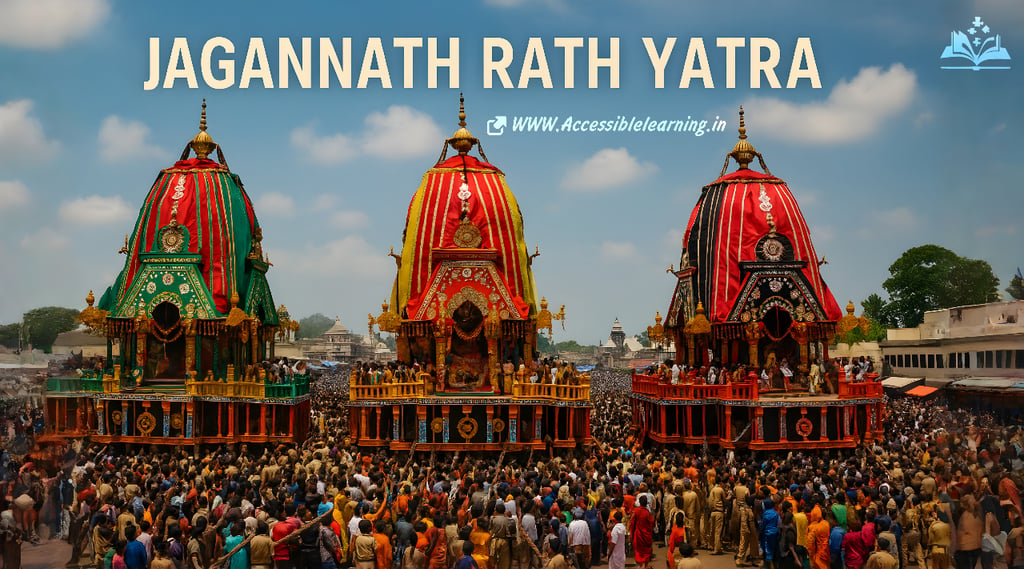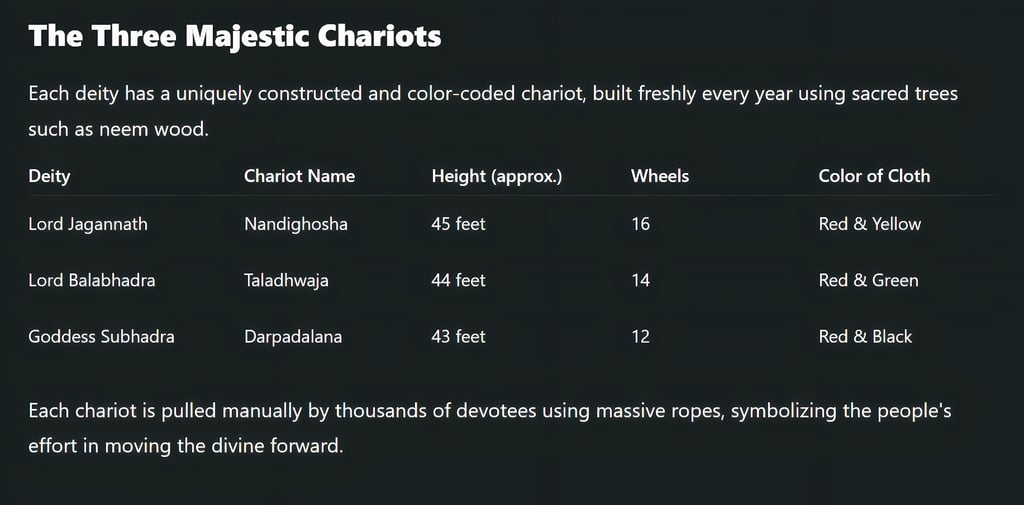
Jagannath Rath Yatra: The Grand Chariot Festival of India
Explore the divine journey of Jagannath Rath Yatra—its spiritual meaning, rituals, mysterious facts, and ancient legends. Discover why millions celebrate this sacred chariot festival.
CULTURE/TRADITIONEVENT/SPECIALTRAVEL LIFEINDIA/BHARATCELEBRATION/FESTIVALS
Keshav Jha / Kim Shin
6/21/20255 min read


Every summer, the spiritual town of Puri in Odisha, India, bursts into vibrant devotion and divine celebration as it hosts the world-renowned Jagannath Rath Yatra. Known as the “Festival of Chariots,” this spectacular event marks the grand journey of Jagannath Ji, Balabhadra Ji, and Maa Subhadra in ornately decorated chariots, pulled by millions of devotees. Blending culture, devotion, and mystery, this age-old festival remains one of the most significant and mesmerizing rituals in Hinduism. In this article, we explore the Yatra’s spiritual significance, history, customs, and intriguing stories that make it an unmissable event on the Indian religious calendar.
Origins Significance
The festival traces its roots to ancient times, referenced in several Puranas, including the Brahma Purana and Padma Purana. According to Hindu mythology:
Lord Jagannath is believed to be a form of Vishnu/Krishna Ji.
The Rath Yatra symbolizes Krishna's journey from Dwaraka to Vrindavan, reuniting with his devotees, the Gopis.
The three deities—Jagannath, Balabhadra, and Subhadra—are taken from their sanctum in the Jagannath Temple to Gundicha Temple, about 3 km away, where they stay for 9 days.
Date & Duration (2025)
In 2025, the Jagannath Rath Yatra will be celebrated on June 29. It falls on the Dwitiya Tithi (second day) of the bright fortnight of the Hindu month Ashadha (June-July).
Return journey (Bahuda Yatra): Typically observed 9 days later.
Suna Besha and Niladri Bije: Ceremonial dress-up and return of the deities to the main temple.


Rituals & Celebrations
Snana Purnima
The festival begins with a ritual bath where the deities are bathed with 108 pitchers of water.
Anasara (Retreat)
After bathing, the idols are believed to fall ill and retreat from public view for two weeks. This is called the Anasara period.
Netrotsav & Nabajouban Darshan
Before the Yatra begins, devotees are allowed to glimpse the deities for the first time after their recovery.
Chhera Pahanra
Performed by the Gajapati King of Puri, this ritual involves sweeping the chariots with a golden broom, symbolizing humility and equality before the divine.
Gundicha Temple Stay
The deities reside in the Gundicha Temple for 9 days, during which special rituals and offerings are made.
Bahuda Yatra
The return journey is equally grand, culminating in the Suna Besha ritual, where the idols are adorned with gold ornaments.
Spiritual & Social Impact
Inclusivity: This is the only time of the year when non-Hindus and foreigners can catch a glimpse of Lord Jagannath.
Egalitarianism: The act of pulling the chariots symbolizes that all are equal before God, regardless of caste or status.
Global Devotion: The International Society for Krishna Consciousness (ISKCON) has helped spread the celebration globally, with Rath Yatras now held in cities like London, New York, and Melbourne.
Tips for Visitors
Accommodation: Book well in advance; hotels fill quickly during the festival week.
Security: Due to the massive crowds, security is tight; follow police and volunteer instructions.
Dress modestly: It’s a religious event; traditional Indian attire is recommended.
Hydrate and prepare: Summers in Odisha can be hot; carry water, hats, and sunscreen.
Jagannath Temple: A Mystery in Itself
The Jagannath Temple is an architectural marvel with many unsolved mysteries:
The temple’s shadow never falls on the ground at any time of the day.
The flag atop the temple always flutters in the opposite direction of the wind.
The prasadam (Mahaprasad) never runs out—irrespective of the number of devotees.

Facts about Jagannath Rath Yatra
No Shadow of the Temple
Despite its massive structure, the Jagannath Temple in Puri casts no shadow—at any time of the day. It's a mystery that continues to baffle engineers and scientists alike.
Flag Flies Against the Wind
The flag atop the temple always flutters in the opposite direction of the wind. It defies natural wind flow and has remained a mystery for centuries.
No Birds Fly Over the Temple
No birds or planes are ever seen flying over the Jagannath Temple—something that's unexplained but observed consistently.
Rebuilt Chariots Every Year
Each of the three colossal chariots is freshly built every year using specific sacred trees such as neem (called Daru). No nails are used—only traditional wooden joinery.
Largest Human-Pulled Chariots in the World
The Rath Yatra features the largest chariots pulled by humans, some over 45 feet tall, weighing up to 60 tons, with massive 7-foot wooden wheels.
Chhera Pahanra by a King
The Gajapati King of Puri, considered the foremost servant of Jagannath Ji, personally sweeps the chariots with a golden broom, symbolizing humility and service.
Prasad That Never Runs Out
The Mahaprasad (divine food offering) is prepared in clay pots stacked one over the other. Surprisingly, the food in the topmost pot cooks first, defying normal heat flow.
Only Time Non-Hindus See the Deities
Non-Hindus are not allowed inside the Jagannath Temple, but during the Rath Yatra, the deities are taken outside, allowing everyone—irrespective of religion—to worship them.
Captivating Stories & Legends
The Making of the Deities & Vishwakarma’s Curse
According to legend, Vishwakarma Ji, the divine architect, agreed to craft the idols of Jagannath, Balabhadra, and Subhadra on the condition that he not be disturbed until completion. However, Queen Gundicha grew impatient and opened the door. Vishwakarma vanished instantly, leaving the deities in their unfinished, stump-like form—which is still worshipped today, symbolizing divine imperfection and universal acceptance.
The Anasara Illness—Humanizing the Divine
After Snana Purnima, when the deities are bathed with 108 pots of sacred water, they fall "sick" and retreat for 15 days in isolation, called Anasara. Devotees believe even the divine needs rest and healing, which beautifully humanizes the gods and strengthens emotional devotion.
The Journey to Aunt Gundicha’s House
The Rath Yatra marks the journey of the divine siblings to their maternal aunt’s house, the Gundicha Temple, where they stay for nine days. This familial aspect makes the divine seem approachable—emphasizing love, affection, and tradition.
Subhadra in the Middle: A Symbol of Balance
In the chariot procession, Subhadra, the only female deity, is placed between her two brothers—Jagannath and Balabhadra. This arrangement signifies balance, protection, and family harmony.
Rath Yatra & Draupadi’s Vision
A story from the Mahabharata connects Draupadi's vision of Krishna with the Jagannath form. She once saw Krishna in a dreamlike trance, appearing without hands or legs. That form was later mirrored in the idols of Jagannath, deeply resonating with bhakti (devotion) through vision.
Jagannath Ji's Global Journey
Thanks to ISKCON (International Society for Krishna Consciousness), the Rath Yatra has gone global. It is now celebrated in over 108 cities worldwide, including New York, London, Moscow, and Sydney—showing Jagannath’s universal appeal beyond borders and cultures.
The Jagannath Rath Yatra is not just a festival—it is a deeply emotional and spiritual experience that brings people together in unity, devotion, and divine celebration. Whether you're a pilgrim pulling the sacred chariot, a spectator immersed in the chants, or a curious soul reading from afar, the Yatra inspires awe and a profound connection to something greater. Its unique blend of history, legend, and devotion makes it one of the most cherished religious processions in the world. In every turn of the chariot’s wheel, it teaches us about faith, humility, and the eternal journey of the soul.
Subscribe To Our Newsletter
All © Copyright reserved by Accessible-Learning Hub
| Terms & Conditions
Knowledge is power. Learn with Us. 📚


